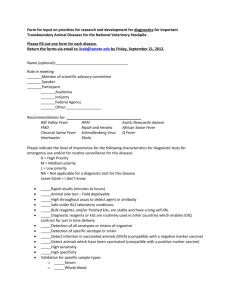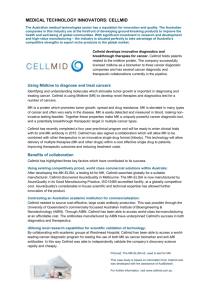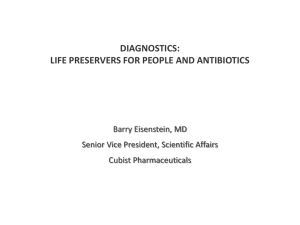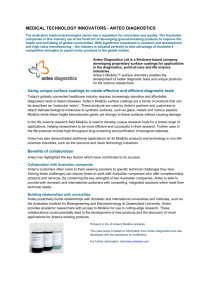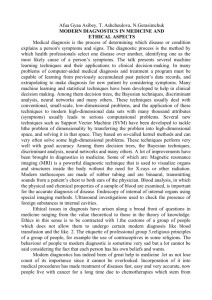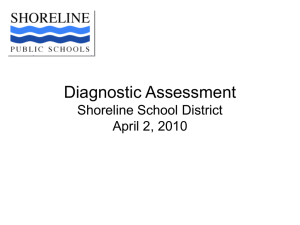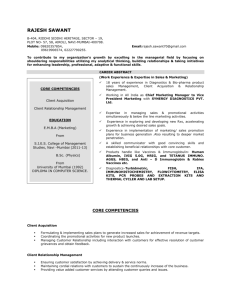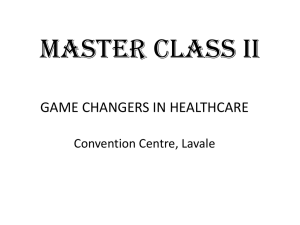1. Progress and results - Department for International Development
advertisement
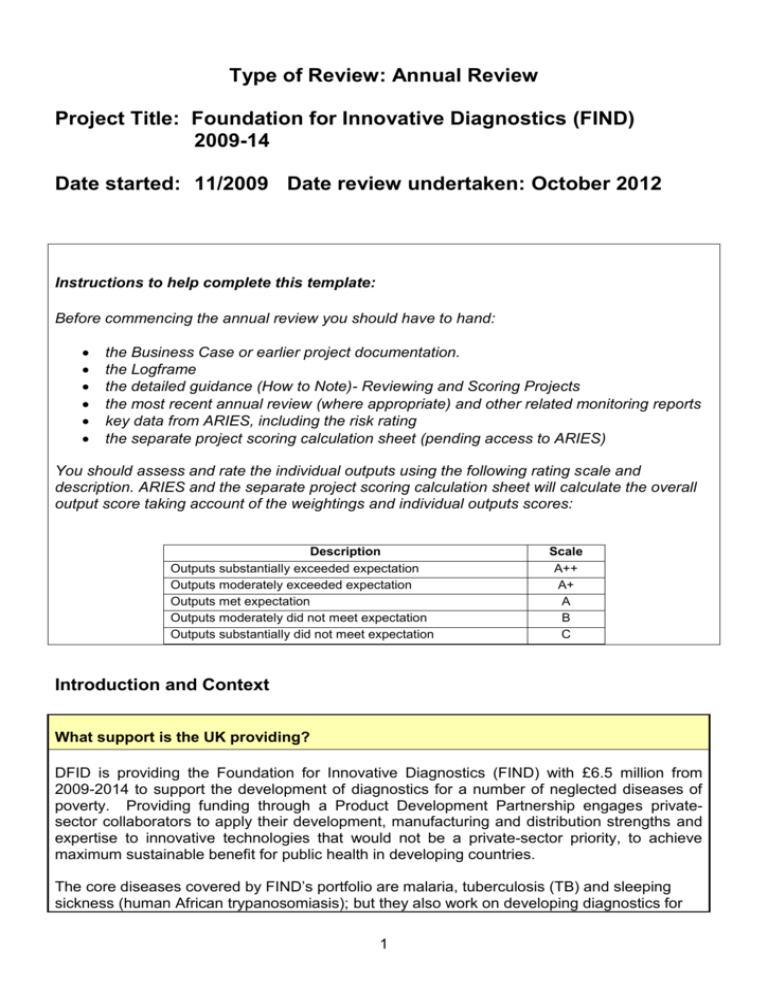
Type of Review: Annual Review Project Title: Foundation for Innovative Diagnostics (FIND) 2009-14 Date started: 11/2009 Date review undertaken: October 2012 Instructions to help complete this template: Before commencing the annual review you should have to hand: the Business Case or earlier project documentation. the Logframe the detailed guidance (How to Note)- Reviewing and Scoring Projects the most recent annual review (where appropriate) and other related monitoring reports key data from ARIES, including the risk rating the separate project scoring calculation sheet (pending access to ARIES) You should assess and rate the individual outputs using the following rating scale and description. ARIES and the separate project scoring calculation sheet will calculate the overall output score taking account of the weightings and individual outputs scores: Description Outputs substantially exceeded expectation Outputs moderately exceeded expectation Outputs met expectation Outputs moderately did not meet expectation Outputs substantially did not meet expectation Scale A++ A+ A B C Introduction and Context What support is the UK providing? DFID is providing the Foundation for Innovative Diagnostics (FIND) with £6.5 million from 2009-2014 to support the development of diagnostics for a number of neglected diseases of poverty. Providing funding through a Product Development Partnership engages privatesector collaborators to apply their development, manufacturing and distribution strengths and expertise to innovative technologies that would not be a private-sector priority, to achieve maximum sustainable benefit for public health in developing countries. The core diseases covered by FIND’s portfolio are malaria, tuberculosis (TB) and sleeping sickness (human African trypanosomiasis); but they also work on developing diagnostics for 1 non-malarial fevers, visceral leishmaniasis (which causes swelling of the liver and spleen, fever and painful skin lesions), trachoma (a leading cause of preventable blindness), Chagas disease and HIV. Alongside product development, FIND supports the development and strengthening of laboratory facilities in disease endemic countries, in order to facilitate the rapid uptake of new tools. What are the expected results? FIND’s goal is to contribute to a world where patients have equitable access to high quality diagnostics. Its purpose is to drive the development and implementation of accurate and affordable diagnostic tests that are appropriate to patient care in low-resource settings. Expected results include: 1. Development of new Point of Care (POC) diagnostics and improved quality of existing POC tests for use at community level; 2. Extension of existing technologies for use in the diagnosis of multiple rather than single diseases, i.e. as diagnostic platforms rather than disease-specific tests; 3. Expansion of activities so that the programme portfolios include new disease areas such as HIV and neglected diseases (where possible building upon the platforms approach); and 4. Increased use of FIND diagnostics for disease testing amongst poor people in endemic countries once the tests have received WHO endorsement. What is the context in which UK support is provided? There are few existing technologies such as diagnostics, drugs and vaccines to identify, treat or prevent neglected diseases that affect the world’s poorest populations. Where they exist the technologies are either too expensive, require high levels of infrastructure (e.g. constant electrical supply, sterile equipment etc.) and high levels of staff training which are not available in settings with weak health systems. For diagnostics there is a need for “point of care” tests that allow for immediate diagnosis, without the need for expensive laboratory infrastructure and skilled staff able to use and maintain the equipment. Support to develop new diagnostics fits within the DFID research strategy to address the need for new or improved products to combat diseases of the poor, for which prevention or treatment is lacking or inadequate. Development of new technologies will help to achieve the Millennium Development Goals, notably to reduce poverty and child mortality, improve maternal health and to combat malaria and other neglected diseases. Section A: Detailed Output Scoring Output 1: Development of new Point of Care (POC) diagnostics and improved quality of existing POC tests for use at community level Output 1 score and performance description: B – output moderately did not meet expectation Progress against expected results: 2 TB: 2011/12 has been a time for consolidating previous successes in molecular testing and advancing new diagnostics in to the portfolio. Key achievements include: A manual molecular diagnostic test for TB (TB LAMP) was registered in Japan and phase 1 evaluation and demonstration projects were conducted in developing countries; On-going work to improve the performance of drug (rifampin) resistance screening; Adoption of 2 new projects, including one which promises the ability to increase the sensitivity and ease of sputum (phlegm) testing for TB in microscopy-level laboratories; FIND and BD (Becton, Dickenson & Company) announced a new collaboration to promote early and accurate diagnosis of multidrug-resistant TB (MDR-TB) among HIVinfected patients and other vulnerable populations in India, a country that accounts for almost 25% of all TB cases globally. Malaria: Key achievements include: First country-level introductions of a new, safer blood transfer device for point-of-care malaria tests completed allowing for the simplification and improved safety of rapid diagnostic test preparation by health workers. Near completion of field studies of rapid diagnostic test (RDT) screening for malaria in pregnancy in Uganda and Burkina Faso Agreement of a new initiative between FIND and University College London (UCL) to assess the feasibility of new approaches to testing for non-tolerance of certain (nonartemisinal) anti-malarial drugs (G6PD testing) allowing for safe treatment of malaria Sleeping Sickness (human African trypanasomiasis): Key achievements include: Identification of biomarkers in the cerebrospinal fluid of sleeping sickness patients that will allow for the distinction between stage 1 and stage 2 disease with a high degree of accuracy – such distinction is critical given that patients with stage 2 disease can suffer severe adverse effects, potentially even death; Signing of an agreement with Standard Diagnostics to develop a rapid diagnostic test that tests for different stages of sleeping sickness and for cure. Recommendations: As the TB portfolio in particular starts to focus upon a range of higher risk projects care will need to be taken to ensure all efforts are made to consolidate work in the areas of greatest promise and halt work in failing projects at the earliest opportunity. Impact Weighting (%): 40% Revised since last Annual Review? Yes – to reflect balance of work in portfolio, following an assessment of risks Risk: Low/Medium/High Medium Revised since last Annual Review? No Output 2: Extension of existing technologies for use in the diagnosis of multiple rather than single diseases, i.e. as diagnostic platforms rather than disease-specific tests. Output 2 score and performance description: B – output moderately did not meet expectation Progress against expected results: Strong progress has been made although not all milestones for the period have been met. Key successes include: Entry of an assay (test) for measuring HIV viral load, and intended to help synergise TB and HIV care, into late stage feasibility testing; 3 Development of the first ever prototype rapid diagnostic test (RDT) for sleeping sickness by FIND and their business partner, Standard Diagnostics (SD), in Korea – early data from on-going trials in Angola and the Democratic Republic of Congo (DRC) suggest this new rapid test performs as well as pre-existing tests which produce results in slower time; Completion of the first field applicable molecular diagnostic test for use in communitybased settings (HAT LAMP) by FIND and their partner, the Eiken Chemical Company; Feasibility studies to develop manual (LAMP) diagnostic tests for both visceral leishmaniasis and Chagas disease initiated Manual malaria diagnostic test (malaria LAMP) completed field trials and is being prepared for market release. Recommendations: FIND set themselves 17 milestones linked to outputs 1, 2 and 4for 2011; of these 11 were for typical product development projects and 6 were for non-typical and implementation projects. Overall, ten milestones were met, 6 were revised and one cancelled (that for the roll-out of the Xpert MTB/RIF assay after it was decided that WHO would take the lead in guiding the implementation of this technology post endorsement). The four main reasons for milestone delays are: technical (difficulty in identifying thermostable targets in 1 project); clinical trial delays (in 3 projects, delays due to slow ethical approval, slow enrolment because of declining endemicity, and a change in principal investigator); and lastly, complications in partner negotiations (for 2 projects). Some further progress has been made in the first half of 2012 and FIND has revised its milestone-setting practices in recognition that some have to date, been over-ambitious, but further efforts are required to ensure these milestones are met in a timely manner. Given that parts of the portfolio associated with output 1 are likely to become higher risk in coming years, FIND’s primary strategic challenge in the coming years will be to continue to select areas of work where they can have the greatest impact and have lower levels of risk. This will also be true for activities relating to output 3. Impact Weighting (%): 15% Revised since last Annual Review? No Risk: Low/Medium/High High Revised since last Annual Review? No Output 3: Expansion of activities so that the programme portfolios include new disease areas such as HIV and neglected diseases (where possible building upon the platforms approach). Output 3 score and performance description: A – output met expectation Progress against expected results: Progress has been relatively strong in this part of FIND’s portfolio, with developments seen across HIV, visceral leishmaniasis and Chagas disease: The TB programme has been expanded to include other diseases where important synergies exist, particularly across HIV and sexually transmitted diseases (STDs) The sleeping sickness programme has been expanded to include leishmaniasis and congenital Chagas disease, with feasibility tests for point-of-care (LAMP) diagnostics for both diseases initiated; Plans to develop trachoma diagnostics are also under development 4 Recommendations: FIND need to be cautious about spreading resources too thinly across too large a range of diseases. Emphasis should remain on the extension of existing diagnostic platforms to new disease areas. Impact Weighting (%): 25% Revised since last Annual Review? Yes to reflect balance of work in the portfolio, following an analysis of risks Risk: Low/Medium/High Medium Revised since last Annual Review? No Output 4: Increased use of FIND diagnostics for disease testing amongst poor people in endemic countries post WHO endorsement and introduction Output 4 score and performance description: A+ – output moderately exceeded expectation Progress against expected results: As various technologies have advanced through the product development pipeline and been endorsed by the WHO, FIND has increased its efforts towards ensuring the availability and use of their diagnostics on the ground in at-risk communities. Activities have included efforts to promote new products, working with partners to reduce technology costs for low and middle income countries, and laboratory strengthening and scale-up projects. Key activities undertaken in the period 2011/12 include: By the end of 2011, liquid culture for TB and phenotypic drug susceptibility testing (DST), the line probe assay for genotypic DST, and a rapid TB speciation test had been introduced to 15 high-burden countries, and the Xpert MTB/RIF for case and multi-drug resistant TB detection to two. Publication of 23 peer-reviewed academic papers since November 2011, with over 90 citations in other articles; Provision of technical support to WHO in the development of policy guidance for the use of the rapid, automated TB test (Xpert MTB/RIF), previously developed by FIND and partners, and endorsed by the WHO in 2011; Deep engagement in early implementation efforts associated with the role out of the automated TB Xpert test, including laboratory capacity-strengthening activities, and Successfully advocating for lower pricing for low and middle income countries (as indicated by an August 2012 announcement that a number of donors are to subsidise the cost allowing for a price reduction from $16.86 per diagnostic cartridge to $9.98 in 145 high-burden countries); On-going quality control for rapid diagnostic tests in partnership with WHO and expansion to include other types of (recombinant antigen) tests; Conduct of a pilot test of the use of SMS (text message) reporting for malaria diagnosis which has led to the national scale up of the approach by the Ministry of Health in Uganda FIND worked with partners including the National Malaria Control Programmes in Senegal and Zambia to assess the impact of wide-scale rapid diagnostic tests (RDTs) on disease reporting and drug consumption with a view to build the evidence base to guide the expansion of RDT use; 5 On-going work towards enhancing the capacity for diagnostic testing for TB, malaria and HIV through laboratory strengthening in Vietnam, Botswana, Dominican Republic, South Africa, Tanzania and Lesotho Recommendations: FIND’s efforts in this area have been impressive during the year. However they may need to balance efforts in this area with the need to maintain an active and progressive diagnostics development pipeline for the future. At the end of 2011 the ‘downstream programme team’ responsible for the delivery of this output began a process of restructuring. FIND must manage this change carefully, to ensure success, to ensure such strong performance in this area is to be maintained. Impact Weighting (%): 20% Revised since last Annual Review? No Risk: Low/Medium/High Medium Revised since last Annual Review? No Section B: Results and Value for Money. 1. Progress and results 1.1 Has the logframe been updated since last review? No 1.2 Overall Output Score and Description: A – Output met expectation 1.3 Direct feedback from beneficiaries FIND has worked to ensure that the diagnostics it develops are appropriate for use in developing countries and can reach those most in need. FIND takes a people-centred approach with a focus on ‘introducing new and improved diagnostic tests to shorten the delay before treatment, to halt transmission, and to minimise the impact of disease on families and communities’ (p.3, The Diagnosis Path to a Better World – available on the FIND website: www.finddiagnostics.org). FIND works closely with governments, regional and district health authorities to facilitate the introduction of new tools into existing systems, supporting the upgrade of laboratories, strengthening technical capacity and ultimately roll-out of new diagnostic tools enabling poor people in communities to access the diagnostics and the right treatments required. 1.4 Summary of overall progress FIND has performed well in the period 2011-12, with slight under-achievements in some areas of their work being offset by over-achievement in others. In the past year while fewer new diagnostics have been endorsed by the WHO and entered the global market than previous years, FIND has continued to demonstrate the development of diagnostics across all stages of the product development pipeline and all three disease areas (TB, malaria, and sleeping sickness). However, they recognise they have not met all their point of care milestones for the year and need to focus upon taking forwards their antigen detection rapid diagnostic testing work particularly for TB. Their work on expanding the diseases covered and developing 6 diseases clusters and increasing use of diagnostics has been strong. 1.5 Key challenges Through the successful development and WHO prequalification of a number of new diagnostic tests FIND has significant challenges to ensure that the new diagnostics will have the desired impact in disease endemic countries. It is clear that FIND is reorganising to ensure sufficient capacity to introduce new diagnostics and associated appropriate uptake. Changes in the senior management and associated organisational restructuring that occurred in 2011-12 are likely to pose some challenges in the period 2012-13. However, FIND is working to ensure these changes are managed as smoothly as possible. FIND needs to ensure that it works with partners who are able to conduct ongoing surveillance of new products once they are being used in the field. Volatile exchange rates and the prolonged effects of the global economic downturn have had an impact on financial operations throughout the year. In common with other Swiss-based organisations the escalation in the value of the Swiss Franc against US $ has greatly increased the Geneva-based costs (e.g. WHO has reported increases of some 40% in operating costs). Many of FIND’s staff are based outside of Switzerland and rigorous financial management is mitigating some of the effect of the currency fluctuations. Finding, reaching and staffing appropriate trial sites in endemic areas, particularly for lower burden diseases such as sleeping sickness, continues to pose challenges. However, FIND’s continuing emphasis on laboratory-strengthening activities in-country helps to reduce these challenges over time. 1.6 Annual Outcome Assessment A – Outcome met expectation FIND has made good progress against its outcome i.e. to drive the development and implementation of accurate and affordable diagnostic tests that are appropriate to patient care in low-resource settings. We anticipate with the changes in management that FIND will continue to perform well during the remainder of the funding period. During the past year FIND has been successful, through a highly competitive process to attract significant funding from the German Government, in its first open competition for product development partnership funding. 2. Costs and timescale 2.1 Is the project on-track against financial forecasts: Yes 2.2 Key cost drivers Diagnostics development is a costly process, especially in the latter stages of development and/or when working on lower burden diseases (which may be targeted for elimination). As new products progress through the pipeline they enter into successively more costly phases of development. The programme is aware and actively trying to manage resources to ensure 7 that there are funds available to test the most promising products as they are developed. This includes widening partnership with the private sector in low, middle and high income countries and leveraging of resources, in-kind contributions and expertise; working with other not-forprofit organisations to share costs wherever possible. Further, diagnostics development remains cheaper than research and development activities in other areas such as vaccines and drug development. FIND’s emphasis on the use of transferable diagnostic platforms further lowers costs and risks. FIND has expanded its portfolio of diseases covered and increased its efforts to ensure diagnostics reach the people most in need. There is a need to ensure a balance across the whole programme of work, within financial constraints, to ensure an active and progressive diagnostics development pipeline for the future During 2012 obtained a significant new funding commitment (EUR7.5million) from the German Federal Ministry of Education and Research, which will run to November 2015, with preexisting donors continuing to support FIND. A two-year, US$11 million, TB grant from the Bill and Melinda Gates Foundation was also granted during 2012. 2.3 Is the project on-track against original timescale: Yes 3. Evidence and Evaluation 3.1 Assess any changes in evidence and implications for the project No significant changes to report. Diagnostics remain an underserved area and FIND continues to be one of the few groups working in the area, with a recognised track record focused solely on diagnostics. In spite of the global financial situation, FIND continues to successfully mobilise funds in an ever more competitive funding environment slight reductions in funding have occurred, but these have only acted to push them towards minimising their operating costs and maximising the efficiency of resource utilisation further. All diseases within their portfolio continue to represent key areas of diagnostic need. 3.2 Where an evaluation is planned what progress has been made? Not applicable 4. Risk 4.1 Output Risk Rating: Medium/High 4.2 Assessment of the risk level Following internal DFID discussions about the risk to the programme it moves from medium to medium/high risk. Product development is high risk and potential new diagnostics can fail at any stage in the development process. Risks are however lower than in other areas of innovation such as vaccine development. The product development partnership model represents a mechanism to mitigate the risks associated with the development of diagnostics (as well as vaccines and drugs) for diseases where there is little likelihood of private-sector diagnostic companies recovering the costs of development. FIND’s strategy to manage a portfolio of diagnostic platforms (rather than single candidates) that can be used across a range of diseases, 8 reduces the overall risk. FIND and their partners have robust mechanisms to manage their portfolios of potential diagnostic products , drawing on global experts to oversee the development process and help teams to identify milestones and stop/go decision points. . As the number of products reaching commercialisation in recent years increases, there is a concurrent portfolio shift towards a larger number of early stage projects which naturally represent higher risk. FIND has strong mechanisms in place to minimise these risks with strong go/no go decision points built in to the product development process. FIND experienced significant management and organisational changes in late 2011, with a new Chief Executive Officer being appointed in 2011 and a subsequent reduction in the number of staff employed by the programme; the long-time Chief Financial Officer (CFO) also retired at the end of the year and a new CFO has taken on the interim-role. FIND is in the process of developing a new 5-year strategy and revising its organisational structure and systems to improve efficiency and reduce operational costs. They have established a permanent Scientific Advisory Committee which will complement the ad-hoc committees to provide external scrutiny for managing individual projects within the portfolio and strengthen both other committees and the Board. While these changes appear to be being managed smoothly, such extensive organisational changes do not come without their risks. These points are reflected in the re-assignment of this programme from ‘medium’ to ‘medium/high’ risk. 4.3 Risk of funds not being used as intended This is low risk. An external independent Financial Audit is performed annually to certify the availability of funds and assess adequacy of funds. Copies of the unqualified Audited Financial Statements for 2011 have been examined by DFID. During the year FIND changed its revenue recognition policy to better reflect the funds available to the organisation at the end of each year. This change in accounting priority, first applied for the period 2011 with retroactive effect on prior years, revealed an accumulated deficit. However the auditors (Deloitte) highlighted that there was sufficient cash to cover FIND’s 2012 operations. FIND’s management and Board of Directors have since taken active measures to resolve the situation. As of August 2012, FIND has secured unrestricted funds from various donors to cover the accumulated deficit. The provision of core funds to manage its portfolio of potential diagnostics is a way to manage the risk that any one project is unsuccessful and that work will stop. The organisation is able to reassign funds to more promising projects and ensure that work continues. FIND has a strong a governance structure and robust practices. In response to previous external reviews, including a 2011 one co-funded by the Bill and Melinda Gates Foundation and the Dutch Government, these have been recently strengthened further (see FIND’s 2011 Annual Funders report for further detail). While this review document has not yet been made public, its conclusions and recommendations have been discussed at length during meetings of the PDP Funders Group and DFID have discussed them with FIND staff members. 4.4 Climate and Environment Risk There are no significant environmental impacts of FIND’s work programme at this time. FIND works with regulators to ensure that environmental issues (associated, for example, with used product and packaging disposal) are appropriately addressed and/or studied as part of the development process, prior to the adoption of tests. The WHO prequalification process for 9 any new diagnostic involves an assessment of potential climate and environment risks. In the longer terms the environmental impacts of FIND’s activities should be positive with reduced inappropriate treatments of disease in poor populations contributing to more effective and efficient utilisation of drugs and associated health services. 5. Value for Money 5.1 Performance on VfM measures Funding diagnostics development through a product development partnership (PDP) such as the Foundation for Innovative Diagnostics (FIND) provides value for money through: the use of a portfolio approach which allows funding to be redistributed if individual projects are stopped if they do not meet their milestones; the leveraging of contributions (resources, expertise, funding, access to drugs and other in-kind resources) from the private sector (in low, middle and high income countries); support for the continued development of the most promising candidates; facilitating opportunities to explore innovative partnerships with private and public sector organisations (in many different countries including low and middle income countries) to reduce costs. FIND further enhances its value for money through strong partnership working with other PDPs (e.g. the TB Alliance) as well as policy-makers, influencers, operational researchers and programme staff on the ground – such involvement significantly increases the likelihood and timeliness of diagnostic uptake in endemic countries. 5.2 Commercial Improvement and Value for Money Through its internal processes, with a focus on the development of new disease diagnostics from existing technology platforms, the programme is able to provide a competitive environment for innovation and improved value for money. In addition the organisation works with the diagnostics industry which improves value for money, by leveraging in resources, staff time and expertise from other organisations 5.3 Role of project partners DFID is one of a number of donors all of whom are involved through regular discussions with the programme directly and through various international and WHO based fora. All donors are aware of the financial constraints and the need to identify ways to increase value for money. Ensuring value for money in developing products for use in low income countries, where there is no viable commercial market, is central to the way PDPs work with their partners from a range of different backgrounds, including pharmaceutical companies, other private sector organisations, academic researchers, advocacy organisations and local community groups. 5.4 Does the project still represent Value for Money : Yes 5.5 If not, what action will you take? 6. Conditionality 10 6.1 Update on specific conditions Not applicable 7. Conclusions and actions Overall FIND has made good progress over the 2011/12 period with slight underachievements under outputs 1 and 2 being offset by strong performance under outputs 3 and 4, supporting the roll-out of diagnostic products among populations at need. There have been some changes in management structures over the cause of the year, the impacts of which appear to have been managed smoothly, and will be monitored closely during the coming year. 8. Review Process The review was carried out by members of the human development research team in DFID, following review meetings and discussions with the programme, independent scientific experts and other funders. A member of the Product Development Partnership Funders Group was an independent member of the review team. Further supporting materials included reports from the FIND website, annual reports and regular FIND email updates As the new Product Development Partnership Competition (for the period 2013-18) was launched in February 2012, there has been minimal contact with FIND to minimise the risk of conflict of interest. All discussions with the programme have been limited to reviewing progress against the existing performance framework, risk, financial and programme management. However, a copy of this annual review was shared with them before submission. When the competition is complete, by end of 2012, further discussions will take place. Given management and organisational changes in 2011-12 we will monitor progress closely over the coming year. 11
